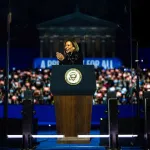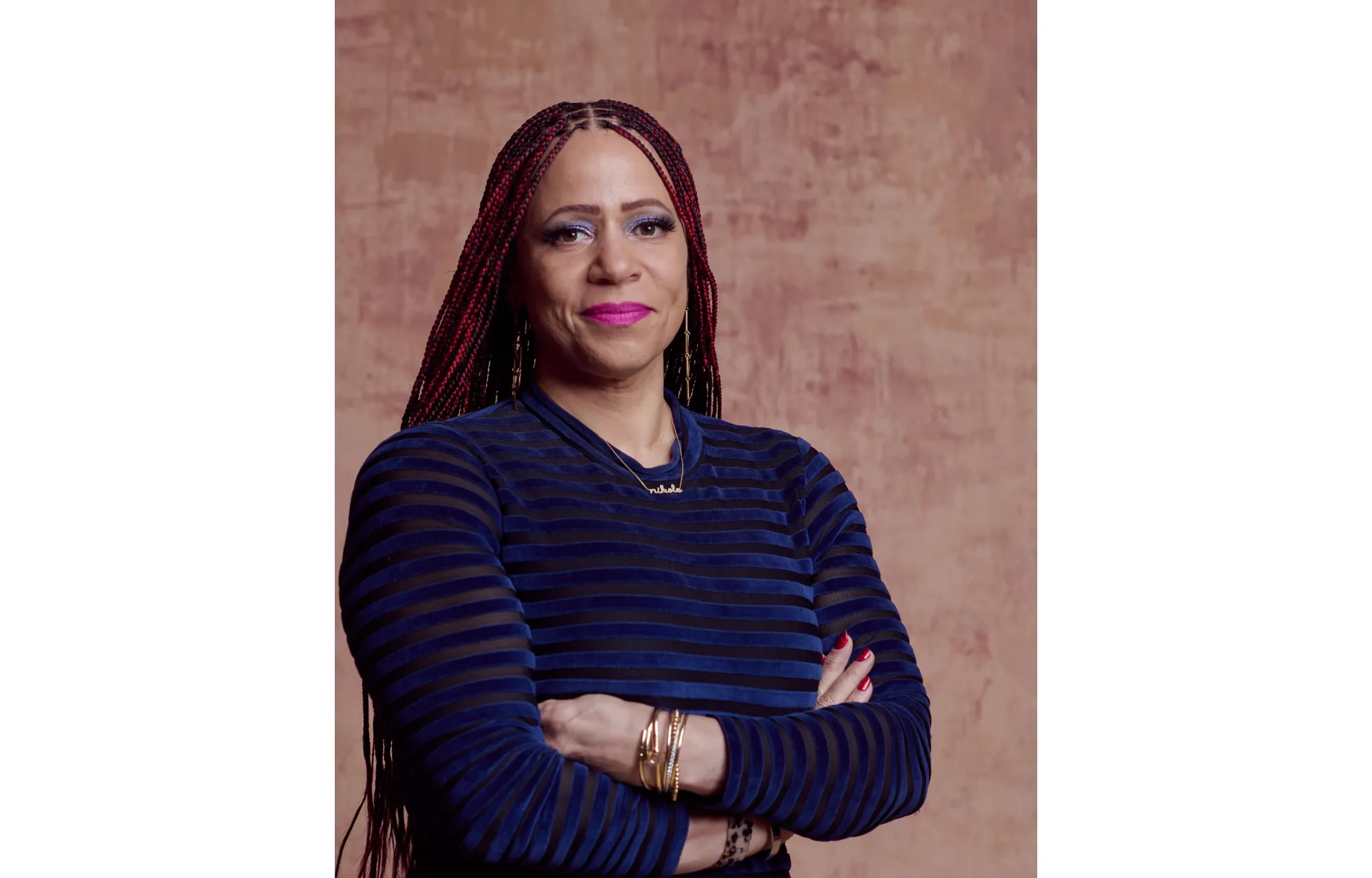
The Brooklyn Public Library‘s Central Branch recently offered a tour of its new 1619 project exhibition with journalist, professor, and art collector Nikole Hannah-Jones.
“My dream from the moment we decided to commission new art was to exhibit the artworks, in some way,” Hannah-Jones said during the press tour last week, noting how inspired she was by Jay-Z’s Book of HOV public exhibition last year. “I’ve never seen a library used in that way before. If we could actually exhibit the art at this library, where there’s literally no ticket for entry. Everyone knows you can come in the library for free.”
The exhibition features 10 original artworks by Black artists from Hannah-Jones’ illustrated art book, The 1619 Project: A Visual Experience. The publication was released five years after the original special 100-page issue of the New York Times Magazine created by Hannah-Jones, which won the Pulitzer Prize for commentary in 2020.
The idea for the art exhibition came about after Hannah-Jones, a member of the board at the Brooklyn Public Library (BPL), was brainstorming ideas for how to launch the book tour of The 1619 Project: A Visual Experience in a “very public space”. Hannah-Jones was also a fan of how the library’s vice president of arts and culture, curator László Jakab Orsós, had programmed the Central Branch’s public spaces.
“Immediately, he was game to do it,” she said. “We didn’t have money to do it. We didn’t know what what it was going to be, but he was confident. ‘We will find a way’.”
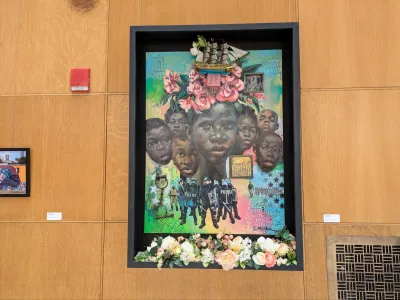
The vision for commissioning work for The 1619 Project: A Visual Experience was a mix of Black artists at different stages in their careers and different stages of renown. Artists were asked to create new work by responding to one of two prompts: resistance or freedom. “Which are the two, to me, defining struggles of Black life,” Hannah-Jones said, noting the artists were then free to interpret those two themes however they wanted. “Nerve-wracking, right? Because you don’t know what you’re going to get.”
However, the small budget and focus on commissions meant some Black artists couldn’t participate, including Mickalene Thomas and Kehinde Wiley.
During the commissioning process, Hannah-Jones also considered the different ways Black artists produce works in different formats. The art exhibition includes a piece of hip-hop jewelry by Johnny Nelson and Hurtful Truth & Hopeful Future (2023), a pair of full-grain leather sneakers by Dr. Dwayne Edwards.
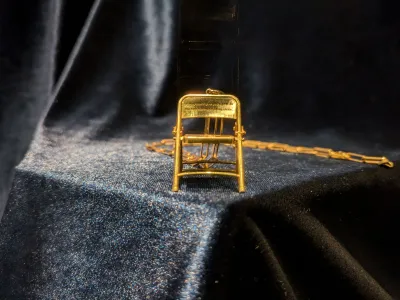
When Hannah-Jones first saw Nelson’s A Gold Seat At the Table (2023), she thought it was a reference to a brawl at the riverfront in Montgomery, Alabama last August which drew national attention. The 14 carat gold vermeil pendant is actually inscribed with a famous quote by Shirley Chisholm, the first Black woman elected to the United States Congress: “If they don’t give you a seat at the table, bring a folding chair”.
“The artist has one thing in mind, but we take it in and it reveals things to us based on what we needed to do,” Hannah-Jones said, noting also how the jewelry piece also reminded her of how Asante royals wore large gold items and the Golden Stool, the Asante empire’s ultimate symbol of power. “There’s just so many echoes to me of black resistance and black culture and our ability to transmute culture across the middle passes.”
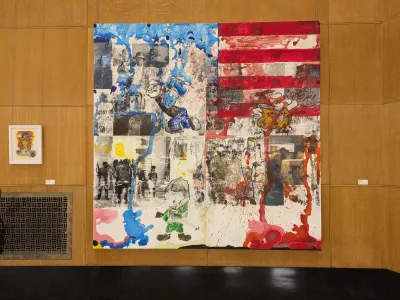
Two of the largest works in the art exhibition are paintings on the theme of resistance: Bryant Lamont’s Every Fucking Day (2022) and Charly Palmer’s Officer/Overseer (2020).
Lamont’s work overlays Elmer Fudd, Popeye, Fred Jones, and Fred Flintsone—iconic figures in white pop culture—over scenes of Black oppression and Black resistance.
“He’s basically arguing Black people are having to struggle against white supremacy every fucking day, for 400 years,” Hannah-Jones said. “And along the side of the piece are all of the race massacres that Black people have experienced since we came on this land. I really love that like if you just stare at it again, it’s just like all these layers.”
Close to Lamont’s painting is Carrie Mae Weems‘ framed photograph Your Resistance Was Found in the Food You Place on the Master’s Table-Ha (1995-1996).
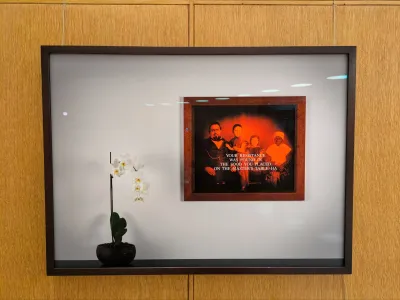
“It makes me laugh,” Hannah-Jones said. “Black women, we’ve been through a lot of shit.”
Hannah-Jones also hopes the art exhibition helps demystify owning art for Black people, especially the idea that work can only be acquired from galleries or for a certain amount.
During the exhibition opening with Studio Museum director Thelma Golden on October 22, the New York Times staff writer noted that Vitus Shell was the first American artist she had collected a piece from a decade ago in Baton Rouge, Louisiana, for $1,200. “I think it’s important to know that there are a range of prices,” she said during the tour, noting most of the artists she’s collected from she found on Instagram. “Art is what you love. And I think so many times we’re made to think like there’s a right way to collect art or you have to collect once they’ve been blessed by some powerful person.”
Hannah-Jones’ personal collection includes has a commissioned piece by Vitus Shell of her daughter. She has also seen the price of works by other artists in her collection go up significantly. “I think it’s important that people collect from artists early in their career,” she said. “I hope people will understand we all can collect art. And before I was collecting in America, I was collecting when I went to Cuba, when I went to Africa.”
The 1619 Project: A Visual Experience also includes archival photos and albums of original photography in between written chapters, both of which are displayed in the art exhibition at the Central Branch next to all the different iterations of The 1619 Project.
These iterations include the anthology The 1619 Project: A New Origin Story, published by Random House in 2021; the children’s picture book The 1619 Project: Born on the Water; and a six-episode documentary television series adaptation, executive produced by Oprah Winfrey and released on Hulu last January.
It’s also worth noting that the Trump administration specifically targeted the 1619 Project and the education programs for students from the Pulitzer Center about it through the 1776 Commission, an advisory committee which advocated for ‘patriotic history’.
When President Donald Trump announced the commission in September 2020, he called lesson plans, reading guides, and other education programs about The 1619 Project “a form of child abuse” and “hateful lies about this country.”
“Critical race theory, the 1619 Project, and the crusade against American history is toxic propaganda, ideological poison that, if not removed, will dissolve the civic bonds that tie us together. It will destroy our country,” Trump said.
The commission’s final report was condemned by the American Historical Association.
The 1619 Project: A Visual Experience is on display at the Brooklyn Public Library’s Central Branch until November 24.
